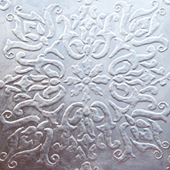Design Resource
Varakh - Jaipur
The Art of Silver or Gold Foils
by
Prof. Bibhudutta Baraland Antony William
The process of varakh making involves the steps:
- Making of rods
- Making of strips
- Making of Varakh
- Cutting of Varakh
- Packaging
Making of Rods:
Silver and gold is bought from the market in the form of biscuits (Dali). These biscuits are melted to convert it into liquid which is then poured into the moulds to make thin rods.
Making of Strips:
These rods are further pressed in pressing-machine to make fine strips of 1 inch width. The process is repeated till the desired thickness is obtained. The strips are folded and kept properly so that they don't get crushed.
Making of Varakh:
Artisans cut small piece of 1 inch length out of the silver/gold strips. These pieces are placed in every page of the Auzaar. The position of each piece of silver/gold is maintained manually so that they are place one over the other. The Auzaar is finally kept in the Pushti (Leather Cover). The flap is closed by applying little amount of water on the surface and then beating it with hammer.
After packing, the artisan starts hammering the booklet exactly at the place where the silver/ gold pieces are placed. After a considerable time the booklet is open again and the placement of the increased/expanded piece of silver/ gold is changed. This is done with each piece and again the booklet is closed and hammered. The placement of silver/gold and hammering is repeated till the desired size is obtained. After which the booklet is sent for cutting of Varakh and packaging. In one day an artisan can make up to 2-3 booklets. This process is done only by the men.
Cutting of Varakh:
In a booklet of 160 pages only 140-130 Varakh are fine to be used further. Rest is considered as wastage and again goes through the process of foil making. The booklet is opened carefully and cheep is fixed at the corner to hold the pages. The wasted/ damaged Varakhs are removed. The removal process is done only by women in their house. The artisan wears paibandi in their finger and applies powder before touching the Varakh.
The Varakh is cut into four parts and each part is turned inside out. This helps in giving clean straight edge to the Varakh. Cutting is done with Phalua. The inner joints are pressed with Phalua so that the edge sticks to each other. The waste Varakhs are used to fill the gaps that occur while pasting the Varakh. Once all the Varakhs are cut and made into rectangular shape they are again gently hammered to make it flat and to remove any kind of over lapping.
Packaging:
After cutting and shaping the Varakh, finally it is placed on a butter paper and covered with another. The paper is folded from between and tied with cotton thread. A bundle of Varakh contains 10 Varakhs.


















